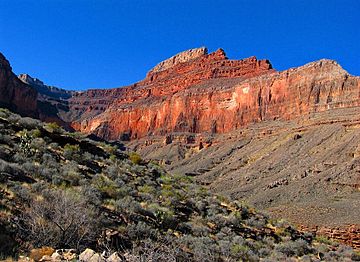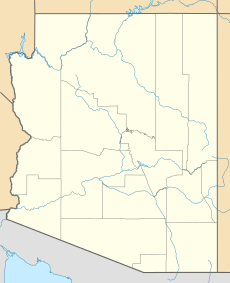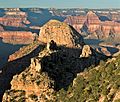Pollux Temple facts for kids
Quick facts for kids Pollux Temple |
|
|---|---|

Northeast aspect, from Tonto Trail
|
|
| Highest point | |
| Elevation | 6,251 ft (1,905 m) |
| Prominence | 762 ft (232 m) |
| Isolation | 1.91 mi (3.07 km) |
| Parent peak | Diana Temple (6,683 ft) |
| Geography | |
| Location | Grand Canyon National Park Coconino County, Arizona, US |
| Parent range | Coconino Plateau Colorado Plateau |
| Topo map | USGS Piute Point |
| Type of rock | limestone, sandstone, mudstone |
| Climbing | |
| First ascent | March 1969 by Alan Doty |
| Easiest route | class 4 climbing |
Pollux Temple is a tall mountain peak, standing 6,251 feet (1,905 meters) high. You can find it in the famous Grand Canyon in northern Arizona, USA. It's about ten miles northwest of Grand Canyon Village.
This peak is quite impressive because it rises almost 4,000 feet (1,220 meters) from the Colorado River below. That's a huge change in height over a short distance! Nearby peaks include Castor Temple to the northwest and Diana Temple to the southeast.
Pollux Temple gets its name from Pollux, a character from Greek mythology. He was believed to be the son of Zeus, a powerful god. A person named Clarence Dutton started the tradition of naming places in the Grand Canyon after gods and heroes from myths.
The area around Pollux Temple has a Cold semi-arid climate. This means it's usually dry, but not extremely hot like a desert.
What Pollux Temple is Made Of
The very top of Pollux Temple is made of a rock layer called the Permian Toroweap Formation. Below that, you'll find a cream-colored rock called Coconino Sandstone. This sandstone forms tall cliffs.
The Coconino Sandstone was created about 265 million years ago. It formed from ancient sand dunes that turned into rock over time.
Underneath the Coconino Sandstone is a reddish, sloped rock layer called the Permian Hermit Formation. Even further down, you'll see the Pennsylvanian-Permian Supai Group.
As you go deeper into the Grand Canyon, you'll find more layers. These include the Mississippian Redwall Limestone, which forms noticeable cliffs. Below that is the Cambrian Tonto Group.
Finally, at the very bottom, near the Colorado River in a place called Granite Gorge, you'll find ancient granite rocks. These are part of the Paleoproterozoic Vishnu Basement Rocks.
Rainwater that falls on Pollux Temple flows north. It travels through Agate and Sapphire Canyons to reach the Colorado River.
Gallery






